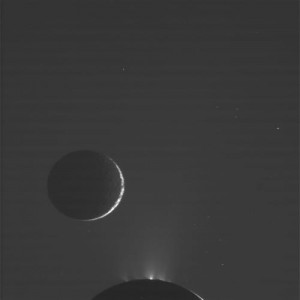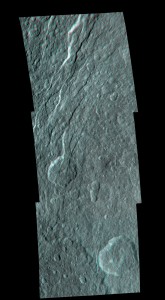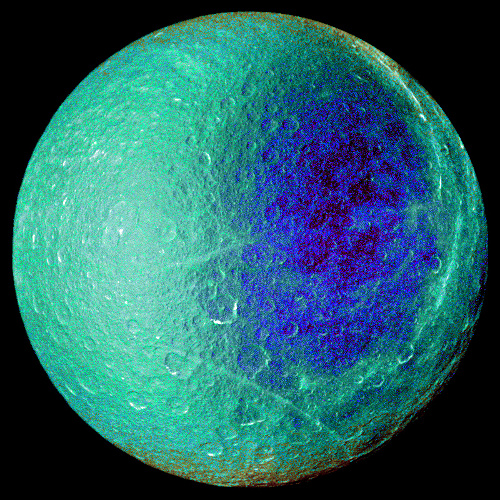Cassini continues to wow us with holiday imagery, not the least of which is this view from the Enceladus encounter on the 20th, with not only the plumes from Enceladus clearly visible but the adjacent image of Mimas stealing the show (credit: NASA/JPL/Space Science Institute). It’s raw imagery, still unprocessed, but it gets across the wonder of the occasion. Cassini’s next encounter is with Rhea, a flyby at 76 kilometers scheduled for January 11, but it’s two earlier Rhea flybys (from November of 2009 and March of 2010) that caught my eye this morning.
Remember that Cassini’s mission has been extended until 2017, offering us the opportunity to enhance considerably our view of the features on various moons. In fact, the recent images of Rhea have already helped us produce a cartographic atlas of the moon that includes names approved by the International Astronomical Union. The 2009 flyby allowed scientists to create a 3-D image of terrain on Rhea’s trailing hemisphere at higher resolution than ever before, showing a densely cratered landscape bisected by uplifted blocks that suggest recent tectonic stress.
The images also tell us something about where Rhea fits in among the family of Saturnian moons, according to Paul Helfenstein (Cornell University), a Cassini imaging team associate:
“These recent, high-resolution Cassini images help us put Saturn’s moon in the context of the moons’ geological family tree. Since NASA’s Voyager mission visited Saturn, scientists have thought of Rhea and Dione as close cousins, with some differences in size and density. The new images show us they’re more like fraternal twins, where the resemblance is more than skin deep. This probably comes from their nearness to each other in orbit.”
Image: Wispy fractures cut through cratered terrain on Saturn’s moon Rhea in this high resolution, 3-D image from NASA’s Cassini spacecraft. Credit: NASA/JPL/Space Science Institute.
The March flyby featured Cassini’s closest pass yet to Rhea at 100 kilometers, but the January event will be closer still, allowing surface details down to the size of a few meters to be imaged. We’ve been able to discount the idea that a faint ring exists above Rhea’s equator while dramatically enhancing our view of the fractures that the Voyagers found there in 1980 and 1981. Both Rhea and Dione have such features, which were once thought to be deposits from cryovolcanic activity or the residue of icy materials from within the moons. Cassini’s higher resolution shows us that the markings are sections of ice along the walls of steep cliffs.
It’s fascinating how much you can tell about terrain from imagery like this. I’m remembering Richard Greenberg’s book Unmasking Europa (2008), which goes into great detail on the analysis of Europan data returned from the Galileo spacecraft. Europa’s ‘chaotic terrain,’ as analyzed in the famous Conamara Chaos region, shows evidence of melt-through followed by reformation of surface ice, a significant eruption that may have resulted from a breakup caused by tidal forces. In any case, Greenberg shows how to reassemble the ‘rafts’ of individual material, demonstrating how they broke away and migrated to new, equally frozen positions.
On Rhea, we’re not dealing with that fascinating, sub-surface ocean that makes Europa so interesting. But close study of the Cassini images shows how fault topography can cut through craters which are themselves not scarred with smaller internal craters, an indication that they’re comparatively young. Meanwhile, the amount of cratering on Rhea’s plains implies that the moon has had little internal activity to cause repaving of surface materials. All of this makes it appear that whatever tectonic stress has caused the fault topography has made its effects felt comparatively recently.
Image: Hemispheric color differences on Saturn’s moon Rhea are apparent in this false-color view from NASA’s Cassini spacecraft. Credit: NASA/JPL/Space Science Institute.
The false-color view above shows the side of Rhea that always faces Saturn. Like other icy Saturnian moons, Rhea shows clear differences in reflectivity and color between its hemispheres that probably reflect changes in surface composition. One cause for this may be the ‘magnetic sweeping’ that occurs when ions trapped in Saturn’s magnetic field are swept over Rhea’s surface. Another likely cause is the impact of meteoritic debris striking one side of the moon more frequently than the other as the tidally-locked moon moves in its orbit. The view here is from approximately 35,000 kilometers.






Got to contribute my family’s signatures which were scanned with thousands of others and put into Cassini before it was launched. Vicariously, we are there. I missed the New Horizons program.
A good blog for issues related to icy moons is Dr Schenk’s 3D House of Satellites – updates aren’t all that frequent but very informative when they come along.
Could the difference in surface reflectively be caused by light being reflected off of Saturn over the eons?
Saturn Storm
Credit: Cassini Imaging Team, SSI, JPL, ESA, NASA; Color Composite: Jean-Luc Dauvergne
Explanation: Late last year, a new, remarkably bright storm erupted in Saturn’s northern hemisphere. Amateur astronomers first spotted it in early December, with the ringed gas giant rising in planet Earth’s predawn sky.
Orbiting Saturn, the Cassini spacecraft was able to record this close-up of the complex disturbance from a distance of 1.8 million kilometers on December 24th.
Over time, the storm has evolved, spreading substantially in longitude, and now stretches far around the planet. Saturn’s thin rings are also seen slicing across this space-based view, casting broad shadows on the planet’s southern hemisphere.
http://antwrp.gsfc.nasa.gov/apod/ap110119.html
Cassini Approaches Saturn
Credit & Copyright: Cassini Imaging Team, ISS, JPL, ESA, NASA, S. Van Vuuren et al.;
Music: Adagio for Strings (NY Philharmonic)
Explanation: What would it look like to approach Saturn in a spaceship? One doesn’t have to just imagine — the Cassini spacecraft did just this in 2004, recording thousands of images along the way, and thousands more since entering orbit.
Recently, some of these images have been digitally tweaked, cropped, and compiled into the above inspiring video which is part of a larger developing IMAX movie project named Outside In. In the last sequence, Saturn looms increasingly large on approach as cloudy Titan swoops below.
With Saturn whirling around in the background, Cassini is next depicted flying over Mimas, with large Herschel Crater clearly visible. Saturn’s majestic rings then take over the show as Cassini crosses Saturn’s thin ring plane. Dark shadows of the ring appear on Saturn itself. Finally, the enigmatic ice-geyser moon Enceladus appears in the distance and then is approached just as the video clip ends.
http://apod.nasa.gov/apod/ap110315.html